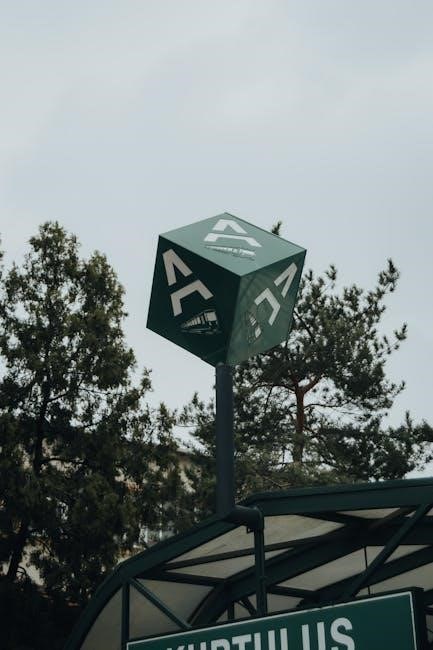The Sibley Guide to Trees is a comprehensive guide covering over 600 tree species in North America, offering detailed illustrations and maps for accurate identification.
1.1 Background and Importance of Tree Identification
Tree identification is essential for understanding ecosystems, conservation, and environmental education. It promotes biodiversity appreciation and informs forestry practices. Accurate identification enables ecological balance, habitat preservation, and scientific research. Field guides like The Sibley Guide to Trees simplify this process, making it accessible to enthusiasts and experts alike, fostering a deeper connection with nature and its complexities.
1.2 Overview of The Sibley Guide to Trees
The Sibley Guide to Trees is a comprehensive field guide authored by David Allen Sibley, offering detailed descriptions of over 600 tree species. It includes vibrant illustrations, range maps, and identification tips, making it a valuable resource for both amateurs and professionals. The guide’s user-friendly design and scientific accuracy set it apart as an essential tool for tree enthusiasts and researchers alike.

Author and Illustrator: David Allen Sibley
David Allen Sibley, a renowned author and illustrator, is celebrated for his meticulous field guides, particularly in ornithology and botany, with a focus on precise detail and accessibility.
2.1 Biography of David Allen Sibley
David Allen Sibley, born in 1961, is the son of renowned ornithologist Fred Sibley. Raised in a family of naturalists, he developed a passion for nature and art early in life. Self-taught in both fields, Sibley began painting birds at age seven; His meticulous attention to detail and ability to capture species’ essence have made him a leading figure in field guide illustration. Married with two children, Sibley resides in Massachusetts, continuing his lifelong dedication to wildlife art and education.
2.2 Sibley’s Contributions to Field Guides
David Allen Sibley’s contributions to field guides are monumental. His meticulous illustrations and detailed descriptions have set a new standard. Sibley’s guides cover species in multiple plumages and seasons, enhancing identification accuracy. His user-friendly approach bridges gaps for beginners and experts, making complex information accessible. This work has revolutionized tree and bird identification, inspiring a new generation of naturalists and scientists alike.
Key Features of The Sibley Guide to Trees
The Sibley Guide to Trees offers comprehensive coverage, detailed illustrations, and a user-friendly design, combining art and science to enhance tree identification for experts and beginners.
3.1 Detailed Illustrations and Maps
The Sibley Guide to Trees features over 4,000 meticulous illustrations, capturing key identification traits like leaves, bark, and fruits. Detailed range maps accompany each species, showing geographic distribution. These visuals, paired with concise descriptions, simplify identification and highlight regional variations, making the guide indispensable for both casual observers and seasoned naturalists.
3.2 Taxonomic Organization and Classification
The Sibley Guide to Trees is organized taxonomically, reflecting current scientific understanding. Trees are grouped by family and genus, with a clear hierarchical structure. This logical arrangement aids in identifying shared characteristics and evolutionary relationships, enhancing the user experience. It is accessible for beginners while providing depth for experts, making it a versatile field guide.
3.4 Coverage of Over 600 Tree Species
The guide covers over 600 tree species, offering extensive diversity. It includes native and cultivated species, providing insights into their habitats and distributions. This comprehensive coverage ensures users can identify trees across various regions. The guide is portable and user-friendly, making it accessible for both casual observers and professional botanists. Its depth and breadth make it an invaluable resource for tree enthusiasts.
Geographic Scope of the Guide
The Sibley Guide to Trees primarily covers North America, including the United States, Canada, and Mexico, encompassing a wide range of tree species in diverse habitats.
4.1 Focus on North America
The Sibley Guide to Trees focuses on North America, covering the United States, Canada, and Mexico. It includes over 600 species, both native and introduced, across diverse habitats like forests, deserts, and urban areas. This regional focus helps users accurately identify trees in their local environments, supported by detailed maps and descriptions for each species.
4.2 USDA Plant Hardiness Zones Covered
The Sibley Guide to Trees covers all USDA Plant Hardiness Zones across North America, from Zone 2 to Zone 11. This ensures comprehensive coverage of tree species adapted to diverse climates, from cold northern regions to warm southern and tropical areas. Detailed descriptions help users identify trees based on local conditions, making it a versatile resource for wide-ranging environments.

User Reviews and Feedback
Praised by experts and enthusiasts, The Sibley Guide to Trees is celebrated for its clarity, detailed descriptions, and logical organization, making tree identification accessible to all skill levels.
5.1 Praise for the Guide’s Clarity and Accuracy
Readers and experts alike commend The Sibley Guide to Trees for its exceptional clarity and precision. The detailed descriptions and illustrations are praised for simplifying complex identification processes, making it accessible to both beginners and seasoned naturalists. Many highlight its logical organization and the use of comparative illustrations, which enhance accuracy. It is widely regarded as a indispensable resource for tree identification.
5.2 Comparisons with Other Field Guides
The Sibley Guide to Trees is often compared to Audubon and Peterson field guides, but it stands out for its detailed illustrations and comprehensive maps. Users appreciate its user-friendly approach, with species organized by shape and family. The guide’s focus on habitat and regional variations makes it a favorite among naturalists and researchers alike for its depth and accessibility.

How to Use The Sibley Guide to Trees
Start by observing tree shape, leaves, bark, and habitat. Use detailed illustrations and maps to narrow down species. Follow the step-by-step identification process for accuracy.
6;1 Step-by-Step Identification Process
Begin by noting the tree’s size, shape, and habitat. Examine key characteristics like leaf type, bark texture, and fruit. Use the guide’s detailed illustrations and range maps to compare features; Follow the systematic organization to narrow down species. Cross-reference descriptions and images to confirm identification. This method ensures accuracy and efficiency, making tree identification accessible for both beginners and experienced users.
6.2 Importance of Observing Key Characteristics
Observing key characteristics, such as leaf shape, bark texture, and fruit type, is crucial for accurate identification. These traits often distinguish similar species. The Sibley Guide emphasizes detailed descriptions and illustrations to help users focus on diagnostic features, ensuring precise and reliable identification. This approach minimizes confusion and enhances the learning experience for tree enthusiasts and professionals alike.

The Sibley Guide vs. Other Tree Identification Resources
The Sibley Guide stands out for its detailed illustrations and comprehensive coverage, offering superior accuracy and ease of use compared to other field guides like Audubon or Peterson.
7.1 Comparison with Audubon Field Guides
The Sibley Guide surpasses Audubon Field Guides in detail and clarity, offering more comprehensive illustrations and species range comparisons. While Audubon guides rely on photography, Sibley’s artwork provides consistent lighting and poses, making identification easier. However, Audubon guides excel in regional specificity, which Sibley balances with broader taxonomic organization and updated classifications.
7.2 Differences from Peterson Field Guides
The Sibley Guide differs from Peterson Field Guides in its extensive species coverage and innovative illustration style. While Peterson guides focus on rapid identification with arrow annotations, Sibley provides detailed, lifelike drawings and range maps for over 600 species. Sibley’s taxonomic organization and comprehensive descriptions make it a more thorough reference for advanced users, though slightly more complex for beginners.

Educational and Practical Applications
The Sibley Guide is a vital tool for ecology students, field biologists, and foresters, offering practical tree identification for professionals and hobbyists alike.
8.1 Use in Academic and Field Ecology
The Sibley Guide is widely adopted in universities and research institutions for its precise descriptions and illustrations, aiding students and professionals in ecology. Its detailed species profiles make it an essential tool for fieldwork, enabling accurate tree identification in diverse habitats. The guide supports ecological studies by providing a reliable reference for understanding tree diversity and distribution.
8.2 Value for Beginners and Experts Alike
The Sibley Guide is praised for its accessibility to newcomers while offering depth for seasoned experts. Beginners appreciate its clear, jargon-free language and intuitive organization, making tree identification approachable. Experts value the guide’s thoroughness, with detailed descriptions and comparisons that aid in distinguishing similar species. This versatility ensures the guide is indispensable for learners and professionals alike.

Accessories and Supplementary Materials
The Sibley Guide is complemented by flashcards, digital apps, and online resources, offering users interactive and portable tools for tree identification and learning on the go.
9.1 Sibley Tree Identification Flashcards
The Sibley Tree Identification Flashcards offer a portable and interactive way to learn tree species. Designed to complement the guide, they feature high-quality images, key characteristics, and quick-reference information. Organized by family or region, these durable cards are ideal for field use, making them a valuable tool for beginners and experts alike to enhance their tree identification skills effectively.
9.2 Digital Resources and Apps
The Sibley Guide to Trees is complemented by digital resources, including a companion app that offers a searchable database of tree species. Features like image recognition, detailed descriptions, and range maps enhance identification. Regular updates ensure the most accurate information. The app is a handy tool for quick reference, making it invaluable for both fieldwork and study, while staying true to Sibley’s meticulous standards.

The Role of The Sibley Guide in Modern Tree Identification
The Sibley Guide to Trees serves as a foundational resource for modern tree identification, offering comprehensive and accessible information essential for ecological research and conservation efforts.
10.1 Impact on Ecological Research
The Sibley Guide to Trees significantly enhances ecological research by providing detailed visual descriptions and range maps, enabling scientists to accurately identify and study tree species. Its comprehensive coverage aids in mapping tree distributions, understanding ecological interactions, and monitoring environmental changes. The guide’s precision supports biodiversity assessments and informs conservation strategies, making it an invaluable tool for researchers and students alike.
10.2 Popularity Among Naturalists and Hobbyists
The Sibley Guide to Trees is widely praised by naturalists and hobbyists for its detailed, portable format and clear visuals. Its user-friendly design makes tree identification accessible to all skill levels, fostering a deeper connection with nature. The guide’s accuracy and comprehensive coverage have made it a favorite among outdoor enthusiasts, enhancing their ability to explore and understand tree diversity with confidence and precision.
Challenges in Tree Identification
Tree identification poses challenges due to similar species, seasonal variations, and the complexity of characteristics, requiring careful observation and reliable resources.
11.1 Similarities Between Species
Identifying trees is challenging due to the striking similarities between species, such as leaf shape, bark patterns, or cone structures. For example, oak and maple leaves can appear alike, while pine and spruce cones may confuse even experienced observers. The Sibley Guide helps overcome this by providing detailed comparisons and diagnostic features, ensuring accurate differentiation between closely related species.
11.2 Regional Variations in Tree Characteristics
Tree characteristics can vary significantly across regions due to differences in climate, soil, and geography. For instance, the same species may exhibit smaller leaves in drier areas or broader leaves in more humid regions. The Sibley Guide accounts for these variations, providing detailed notes and range maps to help users identify trees accurately regardless of location.

The Future of Tree Identification Guides
The future of tree identification guides lies in integrating technology and fostering collaboration between experts and enthusiasts, enhancing accessibility and accuracy for all users.
12.1 Integration of Technology
The integration of technology, such as augmented reality apps, image recognition tools, and interactive maps, will revolutionize tree identification. Enhanced digital platforms can provide real-time updates, improve accessibility, and offer immersive learning experiences, making guides like The Sibley Guide to Trees even more indispensable for future generations of naturalists and researchers.
12.2 Expanding Geographic Coverage
Expanding geographic coverage will enable The Sibley Guide to Trees to address tree species beyond North America, catering to a global audience. This expansion could include regions like Europe, Asia, and South America, providing comprehensive insights into diverse tree species. Enhanced regional maps and updated species classifications will make the guide indispensable for global tree enthusiasts and researchers, fostering broader ecological understanding.
The Sibley Guide to Trees is an indispensable resource for tree identification, offering detailed insights and a user-friendly approach that bridges the gap between experts and enthusiasts.
13.1 Summary of The Sibley Guide’s Strengths
The Sibley Guide to Trees excels with its detailed illustrations, comprehensive coverage of over 600 species, and clear taxonomic organization. Its accuracy, user-friendly design, and inclusion of range maps make it a trusted tool for both beginners and experts, ensuring precise tree identification and fostering a deeper appreciation for North America’s diverse arboreal landscape.
13.2 Final Thoughts on Its Role in Tree Identification
The Sibley Guide to Trees stands as a pivotal resource in tree identification, bridging gaps between enthusiasts and experts. Its meticulous detail and accessible format make it indispensable for anyone exploring North America’s tree species. By combining art and science, it sets a new standard, inspiring a deeper connection with nature and fostering lifelong learning for all users.
References and Further Reading
Published by Alfred A. Knopf, this guide is supported by extensive research and additional resources for deeper exploration of tree identification and ecology.
14.1 Recommended Resources for Advanced Study
For deeper exploration, readers can explore scientific journals like Tree Physiology and databases such as the USDA’s PLANTS database. Websites like iNaturalist offer community-driven insights, while regional field guides provide localized perspectives. Advanced enthusiasts may also benefit from academic publications on dendrology and ecology, complementing Sibley’s foundational guide with specialized knowledge.
14.2 Suggested Local and Regional Guides
Complementing Sibley’s guide, regional resources like the National Audubon Society Field Guides (e.g., for the Northeast or Southeast) offer localized insights. State-specific guides, such as those from local botanical gardens or forestry agencies, provide detailed species accounts tailored to specific areas. These resources are invaluable for understanding regional tree variations and habitats, enhancing identification accuracy and ecological understanding.

About the Publisher
Alfred A. Knopf, founded in 1915, is a renowned publisher known for high-quality books. They have published prestigious works across various genres, including The Sibley Guide to Trees.
15.1 Background on Alfred A. Knopf
Founded in 1915 by Alfred A. Knopf, the publishing house is renowned for its literary excellence and high-quality publications. Knopf has a long history of producing distinguished works, including award-winning fiction, non-fiction, and reference books. Known for its meticulous attention to detail and commitment to quality, Alfred A; Knopf has become a trusted name in publishing, with The Sibley Guide to Trees being one of its notable contributions to natural history literature.
15.2 Other Notable Publications
Alfred A. Knopf is celebrated for publishing iconic works by prominent authors such as Toni Morrison, John Updike, and Gabriel García Márquez. Titles like Beloved and One Hundred Years of Solitude highlight their commitment to literary excellence. Beyond The Sibley Guide to Trees, Knopf has also released influential non-fiction works, further solidifying their reputation as a leading publisher.
Final Thoughts and Encouragement
Exploring trees with The Sibley Guide to Trees fosters a deeper connection to nature. Encouraging readers to observe, learn, and appreciate trees enriches both personal growth and environmental stewardship.
16.1 Encouraging Readers to Explore and Learn
The Sibley Guide to Trees inspires readers to embrace the joy of discovery, fostering a deeper appreciation for nature. By providing detailed insights and practical tools, it encourages everyone to explore their surroundings, learn about tree diversity, and develop a lifelong passion for botany and environmental stewardship. This guide truly serves as a catalyst for curiosity and growth.
16.2 The Joy of Discovering Trees
Discovering trees with The Sibley Guide to Trees brings immense joy and fulfillment, connecting us to nature’s beauty. Each tree tells a story, offering insights into ecosystems and biodiversity. This guide enriches the experience, making tree identification a delightful adventure that fosters curiosity and appreciation for the natural world, inspiring readers to explore and cherish their surroundings.

Leave a Reply
You must be logged in to post a comment.